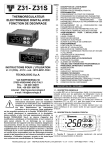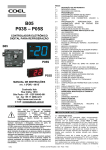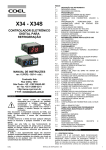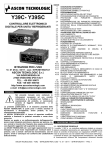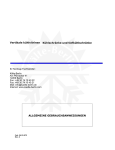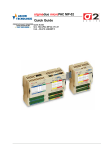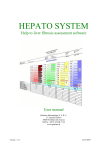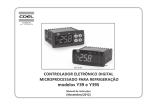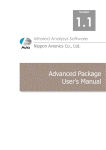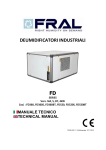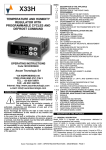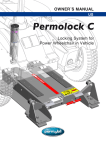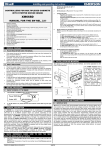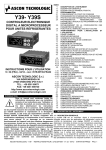Download Word Pro - MZ31
Transcript
Z31- Z31S DIGITAL ELECTRONIC THERMO-CONTROLLER WITH DEFROSTING FUNCTION OPERATING INSTRUCTIONS Vr. 02 (ENG) - 03/12 - cod.: ISTR-MZ31-ENG02 ASCON TECNOLOGIC S.r.l. VIA INDIPENDENZA 56 27029 VIGEVANO (PV) ITALY TEL.: +39 0381 69871 FAX: +39 0381 698730 http:\\www.ascontecnologic.com e-mail: [email protected] FOREWORD INDEX 1 1.1 1.2 2 2.1 2.2 2.3 2.4 2.5 2.6 3 3.1 3.2 3.3 3.4 4 4.1 4.2 4.3 4.4 4.5 4.5.1 4.5.2 4.6 4.6.1 4.7 4.7.1 4.7.2 4.7.3 5 6 6.1 6.2 6.3 7 7.1 7.2 7.3 7.4 7.5 INSTRUMENT DESCRIPTION GENERAL DESCRIPTION FRONT PANEL DESCRIPTION PROGRAMMING FAST PROGRAMMING OF SET POINT STANDARD MODE PARAMETERS PROGRAMMING PARAMETER PROTECTION USING THE PASSWORD CUSTOMIZED MODE PARAMETER PROGRAMMING (PARAMETERS PROGRAMMING LEVEL) RESET PARAMETERS TO DEFAULT VALUE/LEVEL KEYBOARD LOCK FUNCTION INFORMATION ON INSTALLATION AND USE PERMITTED USE MECHANICAL MOUNTING ELECTRICAL CONNECTIONS ELECTRICAL WIRING DIAGRAM FUNCTIONS ON / STAND-BY FUNCTION MEASURING AND DISPLAY TEMPERATURE CONTROL COMPRESSOR PROTECTION FUNCTION AND DELAY AT POWER-ON DEFROST CONTROL MANUAL DEFROST DEFROST DISPLAY LOCK ALARM FUNCTIONS TEMPERATURE ALARMS ACCESSORIES PARAMETERS CONFIGURATION BY “A01” “TVR Y” REMOTE DISPLAY RS 485 SERIAL INTERFACE BY “TLCNV” PROGRAMMABLE PARAMETERS TABLE PROBLEMS , MAINTENANCE AND GUARANTEE SIGNALLING CLEANING GUARANTEE AND REPAIRS TECHNICAL DATA ELECTRICAL DATA MECHANICAL DATA MECHANICAL DIMENSIONS, PANEL CUT-OUT AND MOUNTING FUNCTIONAL DATA INSTRUMENT ORDERING CODE 1 - INSTRUMENT DESCRIPTION 1.1 - GENERAL DESCRIPTION The model Z31 is a digital electronic thermocontroller that is typically used in cooling applications that have temperature control with ON/OFF mode and defrosting control with intervals time by stopping compressor. The instrument has one relay output and one input for PTC or NTC temperature probes, in addition can be equipped with an internal buzzer that is the sound system for alarms. The model Z31S have the “S-touch” capacitive sensor keyboard system. This manual contains the information necessary for the product to be installed correctly and also instructions for its maintenance and use; we therefore recommend that the utmost attention is paid to the following instructions and to save it. 1.2 - FRONT PANEL DESCRIPTION This document is the exclusive property of ASCON TECNOLOGIC which forbids any reproduction and divulgation 8 4 , even in part, of the document, unless expressly authorized. ASCONT ECNOLOGIC reserves the right to make any formal or 6 3 functional changes at any moment and without any notice. Whenever a failure or a malfunction of the device may cause 2 9 dangerous situations for persons, thing or animals, please 1 7 remember that the plant has to be equipped with additional devices which will guarantee safety. 5 10 ASCON TECNOLOGIC and its legal representatives do not assume any responsibility for any damage to people, things or animals deriving from violation, wrong or improper use or in 1 - Key P : Used for setting the Set point (press and release) and for programming the function parameters (hold pressed for 5 sec.) any case not in compliance with the instrument’s features. ASCON TECNOLOGIC - Z31- -OPERATING INSTRUCTIONS- Vr. 02 - 03/12 - ISTR-MZ31-ENG02 - PAG. 1 In programming mode is used to enter in parameters edit mode and confirm the values. In programming mode it can be used together with the UP key to change the programming level of the parameters. When the keyboard is locked it can be used together with the UP (hold pressed for 5 sec.) key to unlock the keyboard. 2 - Key DOWN : In programming mode is used for decreasing the values to be set and for selecting the parameters. 3 - Key UP/DEFROST : In normal mode can be used to start/stop manual defrosting (hold pressed for 5 sec.). In programming mode is used for increasing the values to be set and for selecting the parameters. In programming mode can be used togetherwith key P to change parameters level. Pressed together with the key P for 5 sec. allow the keyboard unlock 4 - Key U : Used (press and release) for visualising the instrument variables (measured temperatures etc.) . In programming mode can be used to come back in normal mode (hold for 2 sec.). It can also be programmed via the parameter “t.UF” In normal mode and if par. “t.UF” = 4 it can be used to turning on and off (stand-by) the device (hold pressed for 1 sec.) 5 - Led SET : In normal mode it serves to indicate when a key is pressed. In programming mode indicates the programming level of the parameters. 6 - Led OUT - COOL : Indicates the output status (compressor or temperature control device) when the istrument is programmed for cooling operation; on (on), off (off) or inhibited (flashing). 7 - Led OUT - HEAT : Indicates the output status (compressor or temperature control device) when the istrument is programmed for heating operation; on (on), off (off) or inhibited (flashing). 8 - Led DEFROST : Indicates defrosting in progress (on) 9 - Led ALARM : Indicates the alarm status (on), off (off) and silenced (flashing) 10 - Led Stand-By: Indicate the Stand-by status. To exit the programming mode, do not press any key for about 30 seconds, or keep the U key pressed for 2 sec. until it exits the programming mode. H o ld f o r 5 sec. H o ld f o r 2 sec. 2.3 - PARAMETER PROTECTION USING THE PASSWORD The instrument has a parameter protection function using a password that can be personalised, through the “t.PP” parameter. If one wishes to have this protection, set the password number desired in the parameter “t.PP”. When the protection is activate, press the P key to access the parameters and keep it press for about 5 seconds, after which the display will show “r.P” . At this point press P, the display show “0”, using the UP and DOWN keys, set the password number programmed and press the key P. If the password is correct, the display will visualise the code that identifies the first parameter and it will be possible to program the instrument in the same ways described in the previous section. Protection using a password can be disabled by setting the parameter “t.PP” = oF. Hold for 5 sec. 2 - PROGRAMMING .1 - FAST PROGRAMMING OF SET POINT Press the key P then release it and the display will show “SP” alternating with the set value. To change it press the UP key to increase the value or DOWN to decrease it. These keys increase or decrease the value one digit at a time, but if the button is pressed for more than one second the value increase or decreases rapidly, and after two seconds pressed, the speed increases even more to all the desired valued to be reached rapidly. When the desired value is set press the key P to exit from Set Point programming mode. Exiting the Set mode is achieved by pressing the P key or automatically if no key is pressed for 10 seconds. After that time the display returns to the normal function mode. 2.2 - STANDARD MODE PARAMETERS PROGRAMMING To access the instrument’s function parameters when password protection is disable, press the key P and keep it pressed for about 5 seconds, after which the display will visualised the code that identifies the first parameter. Using the UP and DOWN keys, the desired parameter can be selected and pressing the P key, the display will alternately show the parameter code and its setting that can be changed with the UP and DOWN keys. Once the desired value has been set, press the key P again: the new value will be memorised and the display will show only the code of the selected parameter. Pressing the UP and DOWN keys, it is possible to select another parameter and change it as described. Hold for 2 sec. Note: If the Password gets lost, just swith off and on the instrument supply, push P key during the initial test and keeping the key pressed for 5 seconds. In this way it’s possible to have access to all the parameters, verify and modify the par. “t.PP”. 2.4 - CUSTOMIZED MODE PARAMETER PROGRAMMING (PARAMETERS PROGRAMMING LEVEL) The password protection hides all the configuration parameters behind a factory set password to avoid unwanted changes being made to the programming of the controller. To make a parameter accessible without having to enter the password when “t.PP” password protection is activate follows this procedure. Enter the programming using the Password “t.PP” and select the parameter which is desired to be accessible with no password protection. Once the parameter has been selected, if the SET led is blinking, this means that the parameter is programmable by entering the password (it’s then “protected”) if it’s instead on, this means the parameter is programmable without password (not protected). If you want to change the accessibility of the parameter push P key, keep it pressed and press together also the key UP. The led SET will change its state indicating the new access level of the parameter (on = not protected; blinking = protected by password). ASCON TECNOLOGIC - Z31- -OPERATING INSTRUCTIONS- Vr. 02 - 03/12 - ISTR-MZ31-ENG02 - PAG. 2 In case some parameters are not protected, when one tries to have access at the programming, the display will show all the parameters not protected and the par. “r.P” (through which will be possible to have access to the “protected” parameters.) Hold for 5 sec. Hold for 2 sec. 2.5 - RESET PARAMETERS TO DEFAULT VALUE/LEVEL The instrument allows the reset of the parameters to values programmed in factory as default. To restore to the values of default the parameters set the value -48 to “r.P” password request. Once confirmed the password with the key P the display it shows "---" for 2 sec. therefore the instrument effects the parameters reset.. Whenever a failure or a malfunction of the device may cause dangerous situations for persons, thing or animals, please remember that the plant has to be equipped with additional devices which will guarantee safety. 3.2 - MECHANICAL MOUNTING The instrument, in case 78 x 35 mm, is designed for flush-in panel mounting. Make a hole 71 x 29 mm and insert the instrument, fixing it with the provided special brackets. We recommend that the gasket is mounted in order to obtain the front protection degree as declared. Avoid placing the instrument in environments with very high humidity levels or dirt that may create condensation or introduction of conductive substances into the instrument. Ensure adequate ventilation to the instrument and avoid installation in containers that house devices which may overheat or which may cause the instrument to function at a higher temperature than the one permitted and declared. Connect the instrument as far away as possible from sources of electromagnetic disturbances such as motors, power relays, relays, solenoid valves, etc. 3.3 - ELECTRICAL CONNECTION Carry out the electrical wiring by connecting only one wire to each terminal, according to the following diagram, checking that the power supply is the same as that indicated on the instrument and that the load current absorption is no higher than the maximum electricity current permitted. As the instrument is built-in equipment with permanent connection inside housing, it is not equipped with either switches or internal devices to protect against overload of current: the installation will include an overload protection and a two-phase circuit-breaker, placed as near as possible to the instrument, and located in a position that can easily be reached by the user and marked as instrument disconnecting device which interrupts the power supply to the equipment. It is also recommended that the supply of all the electrical circuits connected to the instrument must be protect properly, using devices (ex. fuses) proportionate to the circulating currents. It is strongly recommended that cables with proper insulation, according to the working voltages and temperatures, be used. Furthermore, the input cable of the probe has to be kept separate from line voltage wiring. If the input cable of the probe is screened, it has to be connected to the ground with only one side. Whether the instrument is F o G (12 / 24 V) supply version it’s recommended to use an external transformer TCTR, or with equivalent features (Class II insulation) , and to use only one transformer for each instrument because there is no insulation between supply and input. We recommend that a check should be made that the parameters are those desired and that the application functions correctly before connecting the outputs to the actuators so as to avoid malfunctioning that may cause irregularities in the plant that could cause damage to people, things or animals. 2.6 - KEYBOARD LOCK FUNCTION On the instrument it’s possibile to lock completely the keyboard. This function is particularly useful when the regulator is reachable by the users and it’s desired to avoid any modification. To activate the keyboard lock it’s enough program the par. “t.Lo” to a different value to oF. The value program to this parameter it is the time of inactivity of the keys afterwhich the keyboard will be locked. Insofar not pressing any key for the time "t.Lo" the instrument automatically disable the normal functions of the keys. When the keyboard is lock, if any of the key is pushed, on the display will appear “Ln” to indicate the active lock. To unlock the keyboard it’s enough to contemporarily push key P and UP and keep them pushed for 5 sec., afterwhich the label “LF” will appear on the display and all the keys functions will be availab3.4 - ELECTRICAL WIRING DIAGRAM le again . SPST-NO 3 - INFORMATION ON INSTALLATION AND USE NO C INTERNAL BUZZER 3.1 - PERMITTED USE SPDT The instrument has been projected and NO NC C INPUT manufactured as a measuring and control device to be used according to EN60730-1 for the altitudes operation until 2000 ms. The use of the instrument for applications not expressly permitted by the above mentioned OUT rule must adopt all the necessary protective measures. The SUPPLY 61810 60730 instrument CANNOT be used in dangerous environments EN UL EN Out: 16 (9) A 10 (4) A 12 A Res. (flammable or explosive) without adequate protection. 30 LRA The instrument used with NTC 103AT11 probe (identifiable by the 5 FLA PROBE printed code “103AT-11” visible on the sensor part) is compliant (12 A MAX for extr. conn. model) with standard EN 13485 ("Thermometers for measuring the air and product temperature for the transport,storage and distribution of 4 - FUNCTIONS chilled, frozen, deep-frozen/quick-frozen food and ice cream”) with the following classification: [EN13485 air, S, A, 2,- 50°C +90°C] Remember that the end user must periodically checks and verify 4.1 - ON / STAND-BY FUNCTION the thermometers in compliance with standard EN 13486. The instrument, once powered up, can assume 2 different The installer must ensure that EMC rules are respected, also after conditions: the instrument installation, if necessary using proper filters. Z31 1 2 3 4 5 6 7 8 9 10 11 12 ASCON TECNOLOGIC - Z31- -OPERATING INSTRUCTIONS- Vr. 02 - 03/12 - ISTR-MZ31-ENG02 - PAG. 3 - ON : means that the controller uses the control functions. - STAND-BY : means that the controller does not use any control function and the display is turned off except for the led Stand-by. If there is no power, and then power returns, the system always sets itself in the condition it was in before the black-out. The ON/Stand-by function can be selected using the key U if the parameter "t.UF" = 4. Pressing the key U for at least 1 sec., it is possible to switch the instrument from the ON status to Stand-by status and vice versa. Programming instead “r.t1” to any value and “r.t2” = oF the output in probe error condition will remain switched on. Remember that the temperature regulation function can be conditioned by the “Compressor Protections”, “Delay at power on” and “Desfrost” functions. 4.4 - COMPRESSOR PROTECTION FUNCTION AND DELAY AT POWER-ON The function “Compressor Protection” aims to avoid close start ups of the compressor controlled by the instrument in cooling applications. This function foresees 3 time controls on the switching on of the output associated with the temperature regulation request. The protection consists of preventing the output being switched on during the times set in the parameters “P.P1”, “P.P2” and “P.P3” and therefore that any activation occurs only after all the times has finished. First control (par. “P.P1” ) foresees a delay to the output activation (switching-on delay). 4.2 - MEASURING AND DISPLAY Via the parameter “i.SE” it is possible to select the type of probes that one wishes to use and which can be: thermistores PTC KTY81-121 (Pt) or NTC 103AT-2 (nt). Via the parameter “i.uP”, it is possible to select the temperature unit of measurement the desired measurement resolution (C0=°C / 1° ; C1=°C / 0.1° ; F0= °F / 1°; F1= °F / 0.1°). The instrument allows the measuring to be calibrated, that can be used for re-calibrating the instrument according to application needs, through the parameters “i.C1”. Using the parameter “i.Ft”, it is possible to set the time constant Temp. for the software filter for measuring the input values to be able to reduce the sensitivity to measurement disturbances (increasing the r.d SP time). The normal visualisation on the display is the measured temperature but it is possible to visualise the highest and lowest ON ON ON time peak measurement values; by quickly pressing and releasing key Out off U. off off off The display will alternately show: “Lt” and the lowest peak temperature “Ht” and the highest peak temperature Second control (par. “P.P2” ) foresees an inhibition to the “Pr1” and the instant measured temperature activation of the output by a time delay that starts when the output When the instrument is switched off, such values are always re-set. is turning off (delay after switching-off). However, it is also possible to reset these values if the instrument is switched on by using the DOWN key hold for 3 sec. during peak Temp. visualization. The display will show “---” and peaks memory will be reset. r.d The exit of this visualisation mode occurs automatically 15 seconds SP after the last pressing on the key U. Please remember that visualisation of the probe can be changed ON ON ON by the defrosting display lock function, by using the parameter time “d.dL” (see defrost function). Out off off off 4.3 - TEMPERATURE CONTROL P.P2 P.P2 P.P2 The regulation of the instrument is ON/OFF and acts on the output depending on the measuring of probe, of the Set Point “SP”, the Third control (par. “P.P3” ) foresees an inhibition to the activation of the output "Out" by a time delay that starts when the output was intervention differential “r.d” and the function mode “r.HC” . Depending on the function mode programmed on the parameter turning on last time (delay between switching-on). “r.HC” the differential is automatically considered by the regulator with positive values for a Refrigeration control (“r.HC”=C) or with Temp. negative values for a heating control (“r.HC”=H). Temp. Temp. SP r.d r.d SP time ON ON ON r.d SP time ON ON ON ON Out ON off P.P3 ON off P.P3 time off P.P3 During the output inhibition the led OUT (Cool o Heat) blinking. Out Out off off off off It is also possible to prevent activation of the output after the instrument is turned on, for the time set in the parameter “P.od”. r.HC=C r.HC=H During the power on delay phase, the display shows the indication In the event of probe error, it is possible to set the instrument so od, alternating with the normal visualisation. that that the output continues to work in cycles according to the All the functions are disabled by relative parameters = oF. times programmed in the parameter “r.t1” (activation time) and “r.t2” (deactivation time). 4.5 - DEFROST CONTROL If an error occurs on the probe the instrument activates the output The automatic control of defrost, that is by stopping compressor, for the time “r.t1”, then deactivates it for the time “r.t2” and so on occours by interval times whilst the error remains. The automatic defrost function is activate when at the parameter Programming “r.t1” = oF the output in probe error condition will “d.di” is set the defrost interval time. remain switched off. The first defrost after swiching on can be set by par. “d.Sd” ASCON TECNOLOGIC - Z31- -OPERATING INSTRUCTIONS- Vr. 02 - 03/12 - ISTR-MZ31-ENG02 - PAG. 4 This allows to perform the first defrost to a different interval from "d.di." time. If it is desired that to every instrument power on a defrost cycle is realized program the par. "d.Sd" = oF. Instead if is desired all defrost to the same interval program "d.Sd" = "d.di." Automatic defrost function is disable when “d.di” = oF. The instrument provides to switch off the output for the time “d.dE” each “d.di” time (of “d.Sd” in case of first defrost after power on) 4.5.1 - MANUAL DEFROST To start up a manual defrosting cycle, press the key UP/DEFROST when it is not in programming mode and keep it pressed for about 5 seconds after which, if the conditions are correct, the led Defrost will light up and the instrument will carry out a defrosting cycle. To stop a defrosting cycle, press the key UP/DEFROST during the defrost and keep it pressed for about 5 seconds. 4.5.2 - DEFROST DISPLAY LOCK Through par. “d.dL” and “A.dA” it’s possible to define the display behaviour during defrost. The “d.dL” parameter pemits the display visualization lock on the last temperature reading (“d.dL” = on) during all the defrost cycle until, at the end of defrost, the temperature has not reached the lock value or the value [”SP” + “r.d”] or is elapsed the time setted on par. "A.dA". Or it permits only the visualization of label “dEF” (“d.dL” = Lb) during the defrost cycle and, after the defrost, of label “PdF” until, at the end of defrost, the temperature has not reached the lock value or the value [”SP” + “r.d”] or is elapsed the time setted on par. "A.dA". The display will otherwise (“d.dL”= oF) continue to visualize the temperature measured by the probe during the defrost cycle. the probe exceeds or goes below the respective maximum and minimum alarm thresholds. The alarm thresholds will be the same as those set on the parameters “A.HA” and A.LA” if the alarms are absolute (“A.Ay”=1) 4.6 - ALARM FUNCTIONS The alarm conditions of the instrument are: - Probe errors “E1” , “-E1” - temperature alarms “Hi” and “Lo” The alarm functions of the instrument work on the led ALARM and on the internal buzzer, if present and configured via the parameter “o.bu”, The possible selections of the parameter “o.bu” are: = oF - Buzzer always disable = 1 - Buzzer signal active alarms only = 2 - Buzzer signal key pressed only (no alarm) = 3 - Buzzer signal active alarms and key pressed Any active alarm is shown on the instrument display with the lighting up of the ALARM led, the silenced alarm status is shown by the ALARM led flashing . The buzzer (if “o.bu” = 1 or 3) is activated in alarm and can be disabled (alarm silencing) manually by pressing any key of the instrument . 4.6.1 - TEMPERATURE ALARMS The temperature alarms work according to the probe measurement, the type of alarm set in the parameter “A.Ay” the alarm thresholds set in parameters “A.HA” (maximum alarm) and “A.LA” (minimum alarm) and the relative differential “A.Ad”. Through the parameter “A.Ay” it is possible to set the alarm thresholds “A.HA” and “A.LA” which must be considered as absolute (“A.Ay”=1) or relative to the Set Point (“A.Ay”=2). Using some parameters it is also possible to delay the enablement and the intervention of these alarms. These parameters are: “A.PA” - is the temperature alarm exclusion time on switching on the instrument if the instrument is in alarm status when it is switched on. If the instrument is not in alarm status when it is switched on the time "A.PA" it is not considered. “A.dA” - is the temperature alarm exclusion time at the end of defrosting “A.At” - is the temperature alarm delay activation time The temperature alarm is enabled at the end of exclusion time and is enabled after the “A.At” time when the temperature measured by 4.7 - ACCESSORIES The instrument is equipped with a connector that allows the connection of some accessories described as follow. 4.7.1 - PARAMETERS CONFIGURATION BY “A01” It is possible the transfer from and toward the instrument of the functioning parameters through the device A01 with 5 poles connector. This device A01 it’s mainly useable for the serial programming of the instruments which need to have the same parameters configuration or to keep a copy of the programming of an instrument and allow its rapid retransmission. The same device can connect the instrument via USB to a PC and through the proper configuration software tools "TECNOLOGIC UniversalConf”, it’s possible to configure the operating parameters. To use the device A01 it’s necessary that the device or instrument are being supplied. Tem p. A .H A A .A d A .A d A .L A AL o ff ON ON Hi Lo o ff tim e o ff oppure saranno i valori [”SP”+”A.HA”] e [”SP”+”A.LA”] se gli allarmi sono relativi (“A.Ay”=2). Tem p. A .A d A .H A SP A .L A AL A .A d o ff ON ON Hi Lo o ff tim e o ff Gli allarmi di temperatura di massima e di minima possono essere disabilitati impostando i relativi parametri "A.HA" e "A.LA" = oF. SUPPLY USB USB SUPPLY ADAPTER 12 VDC AC SUPPLY For additional info, please have a look at the A01 instruction manual. 4.7.2 - “TVRY” REMOTE DISPLAY To the instrument it is possible to connect the remote display TVR Y through the special cable that can have a maximum length of 10 ASCON TECNOLOGIC - Z31- -OPERATING INSTRUCTIONS- Vr. 02 - 03/12 - ISTR-MZ31-ENG02 - PAG. 5 m. The device TVR Y, directly supplied by the instrument, it allows to visualize the temperature measured by the probe Pr1 through a 2 ½ digit display. SUPPLY cable 10 m MAX. TVR Y For additional info, please have a look at the TVR Y instruction manual. 4.7.3 - RS 485 SERIAL INTERFACE BY “TLCNV” The instrument can be connected by a special cable to the TLCNV device (mod. C - TTL/RS485 interface), by means of which it is possible to connect the regulator with a net to which other instruments (regulators of PLC) are connected, all depending typically on a personal computer used as plant supervisor. Using a personal computer it is possible to acquire all the function information and to program all the instrument’s configuration parameters. The software protocol adopted for the instrument is a MODBUS RTU type, widely used in several PLC and supervision programs available on the market (Y and Z series protocol manual is available on request). If the instrument is used with TLCNV program by the parameter "t.Ad" the station Address. Set a different number for each station, from 1 to 255. Note: The baud-rate are fixed at 9600 baud. TLCNV interface is directly supplied by the instrument. 1 2 3 SUPPLY cable TLCNV TTL TLCNV TX/RX ON 7 8 9 4 5 6 GND B A RS 485 For additional info, please have a look at the TLCNV instruction manual. 5 - PROGRAMMABLE PARAMETERS TABLE Here below is a description of all the parameters available on the instrument. Some of them may not be present because depend on the model/type of instrument. Par. 1 Description Range Def. S. - parameters relative to Set Point -99.9 ÷ HS -50.0 S.LS Minimum Set Point 2 S.HS Maximum Set Point 99.9 LS ÷ HS 0.0 3 SP 4 i. -parameters relative to inputs Pt / nt i.SE Probes Type 5 6 7 Set Point LS ÷ 999 i.uP Unit of measurement C0 / F0 / C1 / and resolution F1 (decimal point) C0 = °C with 1° res. F0 = °F with 1° res. C1 =°C with 0,1° res. F1 = °F with 0,1° res. oF ÷ 20.0 i.Ft Measurement filter sec -30.0 ÷ 30.0 i.C1 Probe Calibration nt C1 2.0 Note °C/°F r. - parameters relative to temperature control Differential 0.0 ÷ 30.0 2.0 (Hysteresis) °C/°F 9 r.t1 Output activation time oF/ 0.01 ÷ 9.59 oF for probe error (min.sec ) ÷ 99.5 (min.sec.x10) 10 r.t2 Output deactivation oF/ 0.01 ÷ 9.59 oF time for probe error (min.sec ) ÷ 99.5 (min.sec.x10) 11 r.HC Output operating mode H-C C H= Heating C= Cooling d. - parameters relative to defrosting control 12 d.di Defrosting interval oF/ 0.01 ÷ 9.59 oF (hrs.min. ) ÷ 99.5 (hrs.min.x10) 13 d.Sd Delay first defrost after oF/ 0.01 ÷ 9.59 oF power-on (min.sec ) ÷ (oF = Defrost at 99.5 power-on) (min.sec.x10) 14 d.dE Lenght of defrost cycle oF/ 0.01 ÷ 9.59 oF (min.sec ) ÷ 99.5 (min.sec.x10) 15 d.dL Defrost display Lock oF - on - Lb oF oF= display free on= Lock on temperature Pr1 before defrost Lb= Lock on label “dEF” (during defrosting) and “PdF” (during post-defrosting) P. parameters relative to compressor protection and power on delay 16 P.P1 Out delay at switch on oF/ 0.01 ÷ 9.59 oF (min.sec ) ÷ 99.5 (min.sec.x10) 17 P.P2 Out delay after switch oF/ 0.01 ÷ 9.59 oF off (min.sec ) ÷ 99.5 (min.sec.x10) 18 P.P3 Out delay between oF/ 0.01 ÷ 9.59 oF switching-on (min.sec ) ÷ 99.5 (min.sec.x10) 19 P.od Delay at power on oF/ 0.01 ÷ 9.59 oF (min.sec ) ÷ 99.5 (min.sec.x10) A. - parameters relative to alarms 20 A.Ay Temperature alarms 1/2 1 Type: (/ 3 / 4 / 5 / 6 / 1 = Absolute 7 / 8 = don’t 2 =Relative to Set use) 21 A.HA High temperature oF / -99.9 ÷ oF Alarm threshold 999 °C/°F 22 A.LA Low temperature oF / -99.9 ÷ oF Alarm threshold 999 °C/°F 23 A.Ad Temperature Alarms 0.0 ÷ 30.0 1.0 Differential °C/°F 24 A.At Temperature Alarms oF/ 0.01 ÷ 9.59 oF delay (min.sec ) ÷ 99.5 (min.sec.x10) 8 r.d 0.0 ASCON TECNOLOGIC - Z31- -OPERATING INSTRUCTIONS- Vr. 02 - 03/12 - ISTR-MZ31-ENG02 - PAG. 6 6.1 - SIGNALLING Error Reason The probe may be E1 interrupted (E) or in -E1 short circuit (-E), or may measure a value outside the range allowed Internal EEPROM EPr memory error Fatal memory error Err Other Signalling: Message od Ln dEF PdF Hi Lo Action Check the correct connection of the probe with the instrument and check the probe works correctly Press key P Replace the instrument or ship to factory for repair Reason Delay at power-on in progress Keyboard lock Defrosting in progress with “d.dL”=Lb Post-defrosting in progress with “d.dL”=Lb Maximum temperature alarm in progress Minimum temperature alarm in progress 6.2 - CLEANING We recommend cleaning of the instrument only with a slightly wet cloth using water and not abrasive cleaners or solvents. 6.3 - GUARANTEE AND REPAIRS The instrument is under warranty against manufacturing flaws or faulty material, that are found within 12 months from delivery date. The guarantee is limited to repairs or to the replacement of the instrument. The eventual opening of the housing, the violation of the instrument or the improper use and installation of the product will bring about the immediate withdrawal of the warranty’s effects. In the event of a faulty instrument, either within the period of warranty, or further to its expiry, please contact our sales department to obtain authorisation for sending the instrument to our company. The faulty product must be shipped to ASCON TECNOLOGIC with a detailed description of the faults found, without any fees or 7 - TECHNICAL DATA 7.1 - ELECTRICAL DATA Power supply: 12 VAC/VDC, 12...24 VAC/VDC, 100...240 VAC +/10% Frequency AC: 50/60 Hz Power consumption: 3 VA approx. Input/s: 1 input for temperature probes: PTC (KTY 81-121, 990 Ω @ 25 °C) or NTC (103AT-2, 10KΩ @ 25 °C). Output/s: 1 relay output SPST-NO or SPDT EN 61810 EN 60730 UL 60730 Out - 16A - 1HP 16 (9) A 10 (4) A 12 A Res., 250V, 1/2HP 125 30 LRA, VAC 5 FLA 12 A Max. for extractable terminal block model Electrical life for relay outputs: 100000 op. (EN60730) Action type: type 1.B (EN 60730-1) Overvoltage category: II Protection class : Class II Insulation: Reinforced insulation between the low voltage part (supply H type and relay output) and front panel; Reinforced insulation between the low voltage section (supply H type and relay output) and the extra low voltage section (inputs); Reinforced between supply and relay output; No insulation between supply F or G type and inputs. 7.2 - MECHANICAL DATA Housing: Self-extinguishing plastic, UL 94 V0 Heat and fire resistance category : D Ball Pressure Test secondo EN60730: acessible parts 75 °C; support live parts 125 °C Dimensions: 78 x 35 mm, depth 64 mm Weight: 120 g approx. Mounting: Incorporated Flush in panel (thickness max. 12 mm) in 71 x 29 mm hole Connections: 2,5 mm2 screw terminals block or 2,5 mm2 extractable screw terminals block for 0,2...2,5 mm2 / AWG 24...14 cables. Degree of front panel protection : IP 65 (NEMA 3S) mounted in panel with gasket Pollution situation: 2 Operating temperature: 0 T 50 °C Operating humidity: < 95 RH% without condensation Storage temperature: -25 T +60 °C 7.3 - MECHANICAL DIMENSIONS, PANEL CUT-OUT AND MOUNTING [mm] 78 35 6 - PROBLEMS, MAINTENANCE AND GUARANTEE charge for ASCON TECNOLOGIC, except in the event of alternative agreements. 78 35 25 A.PA Temperature Alarms oF/ 0.01 ÷ 9.59 2.00 delay at power on (hrs.min. ) ÷ 99.5 (hrs.min.x10) 26 A.dA Temperature Alarms oF/ 0.01 ÷ 9.59 1.00 delay and unlock (hrs.min. ) ÷ display delay after 99.5 defrost (hrs.min.x10) o. -parameters relative to buzzer 27 o.bu Buzzer function mode oF / 1 / 2 / 3 3 oF = disable 1 = active alarms only 2 = key pressed only 3 = active alarms and key pressed t. - parameters relative to configuration of the keyboard 28 t.UF Function mode key U oF / 4 oF oF= No function (1 / 2 / 3 = 4= Switch on/Switch don’t use) off (Stand-by) 29 t.Lo Keyboard lock function oF/ 0.01 ÷ 9.59 oF delay (min.sec ) ÷ 30.0 (min.sec.x10) 30 t.PP Access Password to oF ÷ 999 oF parameter functions 31 t.AS MODBUS Station 0 ÷ 255 1 address (for serial communication) ASCON TECNOLOGIC - Z31- -OPERATING INSTRUCTIONS- Vr. 02 - 03/12 - ISTR-MZ31-ENG02 - PAG. 7 7.5 - INSTRUMENT ORDERING CODE min. 15 mm Z31- (instrument with mechanical keyboard ) Z31S (instrument with Sensitive Touch keyboard ) 29 71 min. 12 mm a b c d e f g h ii jj RECOMMENDED PANEL CUTOUT a : POWER SUPPLY H = Supply 100..240 VAC G = Supply 12..24 VAC/VDC F = Supply 12 VAC/VDC b : OUT R = Out Relay SPST-NO 16A S = Out Relay SPDT 16A 6 28 c : BUZZER - = (No) B = Buzzer 64 e : DISPLAY - = Red B = Blue 12,2 f, g, h : INTERNAL CODES 28 6 d : TERMINAL BLOCK - = (Standard) E = Extractable screw terminal block complete N = Extractable terminal block without removable connectors ii, jj : SPECIAL CODES 64 BRACKETS MAX 12 mm PANEL + GASKET 34 7.4 - FUNCTIONAL FEATURES Temperature Control: ON/OFF mode Defrost control: interval cycles by stopping compressor Measurement range: NTC: -50...109 °C / -58...228 °F; PTC: -50...150 °C / -58 ... 302 °F Display resolution: 1 ° or 0,1° (range -99.9 ...99.9 °) Overall accuracy: +/- (0,5 % fs + 1 digit) Sampling rate: 130 ms. Display: 3 Digit Red (or Blue as option) h 15,5 mm Software class and structure : Class A Compliance: Directive 2004/108/CE (EN55022: class B; EN610004-2: 8KV air, 4KV cont.; EN61000-4-3: 10V/m; EN61000-4-4: 2KV supply and relay outputs, 1KV inputs; EN61000-4-5: supply 2KV com. mode, 1 KV\ diff. mode; EN61000-4-6: 3V); Directive 2006/95/CE (EN 60730-1, EN 60730-2-9). Regulation 37/2005/CE (EN13485 air, S, A, 2,- 50°C +90°C with probe NTC 103AT11). ASCON TECNOLOGIC - Z31- -OPERATING INSTRUCTIONS- Vr. 02 - 03/12 - ISTR-MZ31-ENG02 - PAG. 8








